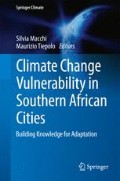Abstract
As stated in the fourth report of the Intergovernmental Panel on Climate Change (IPCC), climate change is affecting temperatures, sea levels, and storm frequencies in the entire world. While changes in average conditions can have serious consequences by themselves, the main impacts of climate change will be felt through weather extremes and the consequent risk of natural disasters. This chapter provides an overall picture of the climate conditions in the Maputo region, through the analysis of climatic data from the Maputo-Mavalane station (1960–2006). The current climate dynamics are analyzed and future climate scenarios are briefly considered, based on the literature of Mozambique. The study is especially focused on the aspects that most influence the management of a large city like Maputo. As such, attention is centered on the analysis of intense phenomena. The aim of this work is to contribute to local administrators’ understanding of climatic phenomena and their processes.
Access this chapter
Tax calculation will be finalised at checkout
Purchases are for personal use only
References
Boko M, Niang I, Nyong A, Vogel C, Githeko A, Medany M, Osman-Elasha B, Tabo R, Yanda P (2007) Africa. Climate change 2007: impacts, adaptation and vulnerability. In: Parry ML, Canziani OF, Palutikof JP, van der Linden PJ, Hanson CE (eds) Contribution of working group II to the fourth assessment report of the intergovernmental panel on climate change. Cambridge University Press, Cambridge, pp 433–467
Bornstein R D (1968) Observations of the Urban Heat Island effect in New York City. J Appl Meteor 7:575–582. http://dx.doi.org/10.1175/1520-0450(1968)007<0575:OOTUHI>2.0.CO;2
Giridharan R, Ganesan S, Lau SSY (2004) Daytime urban heat island effect in high-rise and high-density residential developments in Hong Kong. Energy Build 36(6):525–534. http://dx.doi.org/10.1016/j.enbuild.2003.12.016
Gumbel EJ (1954) Statistical theory of extreme values and some practical applications. Applied mathematics series 33. U.S. Department of Commerce, National Bureau of Standards
INGC (2009) INGC climate change report: study on the impact of climate change on disaster risk in mozambique. In: Asante K, Brundrit G, Epstein P, Fernandes A, Marques MR, Mavume A, Metzger M, Patt A, Queface A, Sanchez del Valle R, Tadross M, Brito R (eds) Main report. INGC, Mozambique
Kottek M, Grieser J, Beck C, Rudolf B, Rubel F (2006) World map of the Köppen-Geiger climate classification updated. Meteorol Z 15:259–263. doi:10.1127/0941-2948/2006/0130
Li Q, Zhang H, Liu XJ (2004) Urban heat island effect on annual mean temperature during the last 50 years in China Huang. Theor Appl Climatol 79(3–4):165–174. doi: 10.1007/s00704-004-0065-4
McKee TB, NJ Doesken and J Kliest (1993) The relationship of drought frequency and duration to time scales. In: Proceedings of the 8th conference of applied climatology, 17–22 Jan, Anaheim, CA. American Meterological Society, Boston, pp 179–184
New M et al (2006) Evidence of trends in daily climate extremes over Southern and West Africa. J Geophys Res 111:D14102. doi:10.1029/2005JD006289
Nicholson SE, Kim J (1997) The relationship of the El Nino-Southern oscillation to African rainfall. Int J Climatol 17(2):117–135
Oke TR (1982) The energetic basis of the urban heat island. QJR Meteorol Soc 108:1–24. 10.1002/qj.49710845502
Wessa P (2011) Free statistics software, office for research development and education, version 1.1.23-r6. http://www.wessa.net/
Zebiak SE, Cane MA (1987) A model EI Nino-Southern Oscillation. Mon Weather Rev 115(10):2262–2278
Author information
Authors and Affiliations
Corresponding author
Editor information
Editors and Affiliations
Rights and permissions
Copyright information
© 2014 Springer International Publishing Switzerland
About this chapter
Cite this chapter
Bacci, M. (2014). Climate Change Hazard Identification in the Maputo Area. In: Macchi, S., Tiepolo, M. (eds) Climate Change Vulnerability in Southern African Cities. Springer Climate. Springer, Cham. https://doi.org/10.1007/978-3-319-00672-7_9
Download citation
DOI: https://doi.org/10.1007/978-3-319-00672-7_9
Published:
Publisher Name: Springer, Cham
Print ISBN: 978-3-319-00671-0
Online ISBN: 978-3-319-00672-7
eBook Packages: Earth and Environmental ScienceEarth and Environmental Science (R0)

